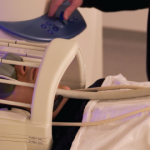Despite a growing recognition and appreciation for the neurobiology of chronic pain, ongoing studies struggle to find specific and unique pain biomarkers, according to Professor Jones. “This is still very much an evolving field of research,” he says.
Recent Research

Dr. Harris
Among the more recent research in this field is a study published by researchers at the University of Michigan that examined whether brain structures or connectivity patterns associated with widespread pain could be identified on neuroimaging.3 “We and others have noticed that many patients with localized pain conditions, such as knee osteoarthritis and pelvic pain, have pain in locations other than where their primary complaint is,” says the study’s senior author, Richard Harris, PhD, associated professor of Anesthesiology and Rheumatology at Michigan Medicine in Ann Arbor, Mich.
Using data from 1,079 participants in the Multidisciplinary Approach to the Study of Chronic Pelvic Pain Research Network (MAPP) study, Harris and colleagues compared three cohorts: patients with a clinical diagnosis of urological chronic pelvic pain syndrome (UCPPS), a pain-free control group and patients with fibromyalgia. All participants completed questionnaires on pain severity, function and pain location. A subset also underwent functional and structural magnetic resonance imaging.
The study found that some of the patients with UCPPS had pain beyond the pelvic area, and that those with widespread pain showed changes in brain structure and function identical to the changes seen in the fibromyalgia. Specifically, widespread pain in both the UCPPS and fibromyalgia patients was associated with increases in brain gray matter and connectivity in sensory encoding brain areas.
The implications of these findings point to what researchers hope they can reap from this entire line of investigation. “It’s important to realize that a person who presents with localized pain may also have a more broad body pain presentation that may respond better to centrally acting interventions, as opposed to treatment focused on the local complaint,” says Dr. Harris.
Yes, It’s All in Their Head
This research and ongoing investigation shows chronic pain is indeed all in the patient’s head—specifically, their brain. “The question often is, ‘So the pain is all in my head, is it?’ to which the answer is yes, it must be, because that’s where the brain is, and pain can only be experienced as a result of activity in the brain,” says Professor Jones. This once meant a dismissal of a patient’s subjective experience, but the evolving understanding of pain as a brain problem now means neuroimaging can capture pain pathways, thereby possibly allowing doctors to devise treatment measures that better ease both the physical and emotional discomfort of pain than traditional measures.
